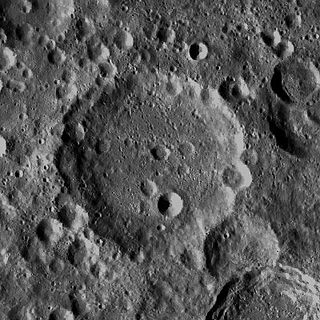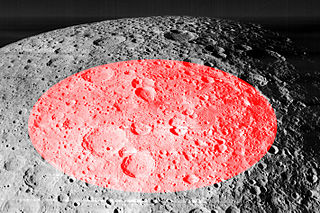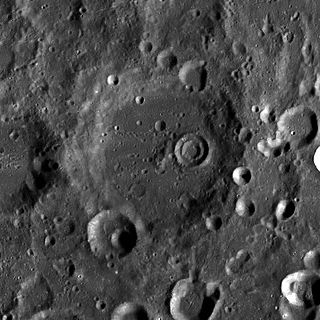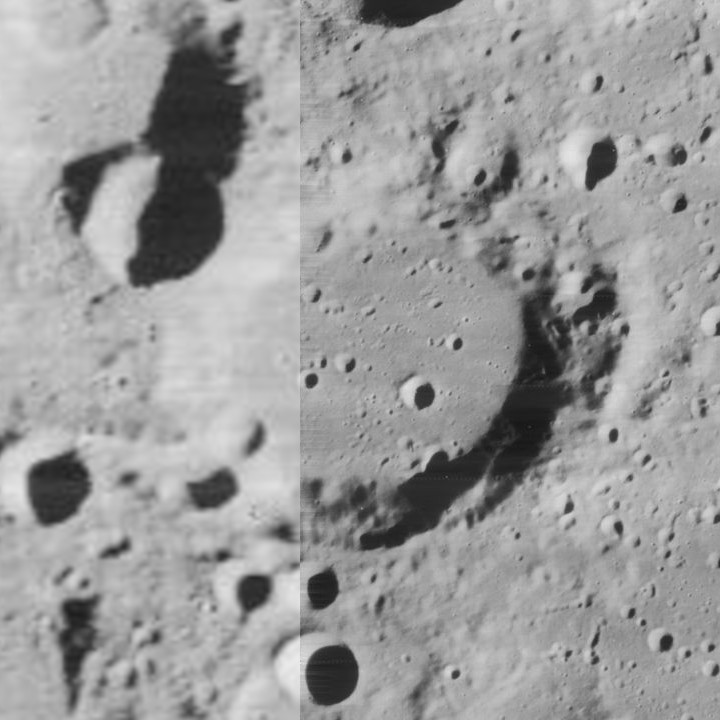 LRO mosaic | |
| Coordinates | 13°18′N165°36′E / 13.3°N 165.6°E Coordinates: 13°18′N165°36′E / 13.3°N 165.6°E |
|---|---|
| Diameter | 156 km |
| Depth | Unknown |
| Colongitude | 195° at sunrise |
| Eponym | Harold Spencer Jones |


Spencer Jones is a lunar impact crater on the Moon's far side. It is a roughly circular feature with a rim edge that is only moderately eroded. The inner wall of Spencer Jones is wider than elsewhere. The interior floor is relatively level with a low ridge offset to the south of the midpoint. Attached to the southwestern outer rim is the small satellite crater Spencer Jones Q.

Lunar craters are impact craters on Earth's Moon. The Moon's surface has many craters, almost all of which were formed by impacts.

An impact crater is an approximately circular depression in the surface of a planet, moon, or other solid body in the Solar System or elsewhere, formed by the hypervelocity impact of a smaller body. In contrast to volcanic craters, which result from explosion or internal collapse, impact craters typically have raised rims and floors that are lower in elevation than the surrounding terrain. Impact craters range from small, simple, bowl-shaped depressions to large, complex, multi-ringed impact basins. Meteor Crater is a well-known example of a small impact crater on Earth.

Earth's Moon is an astronomical body that orbits the planet and acts as its only permanent natural satellite. It is the fifth-largest satellite in the Solar System, and the largest among planetary satellites relative to the size of the planet that it orbits. The Moon is, after Jupiter's satellite Io, the second-densest satellite in the Solar System among those whose densities are known.
It is named after British astronomer Harold Spencer Jones.
Sir Harold Spencer Jones KBE FRS FRSE PRAS was an English astronomer. He became renowned as an authority on positional astronomy and served as Astronomer Royal for 23 years. Although born "Jones", his surname became "Spencer Jones".
Just over 20 km from Spencer Jones is the slightly smaller crater Papaleksi to the south-southwest. To the northeast lies Anderson.

Papaleksi is an impact crater on the far side of the Moon. It lies along the northeastern outskirts of the large crater Mandel'shtam. About 20 km to the north-northeast of Papaleksi is the similar crater Spencer Jones.

Anderson is a lunar impact crater that is located on the far side of the Moon. It is located to the northwest of the crater Sharonov, and the satellite crater Sharanov X is attached to the southeast rim of Anderson. To the northeast is the peculiar formation Buys-Ballot, and to the east-southeast lies the larger crater Spencer Jones.
The crater lies at the southwest margin of the Freundlich-Sharonov Basin.

The Freundlich-Sharonov Basin is a Pre-Nectarian impact basin on the far side of the moon. It is named after the younger craters Freundlich near the northwest margin and Sharonov near the southwest margin. It lies east of Mare Moscoviense basin and northwest of Korolev basin.




















